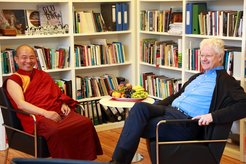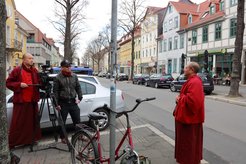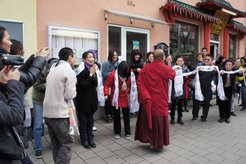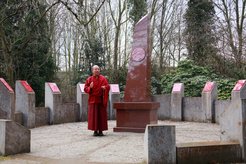Practicing Public Anthropology with Khenpo Sodargye
by Dan Smyer Yu
Public anthropology, advocated by Rob Borofsky in the late 20th century, has become widely accepted among anthropologists and other social scientists. It takes us a few steps further than the “reflexive” and “interpretive” turns of George Marcus, James Clifford, and Paul Rabinow, all of which are concerned with the preservation of anthropology by critically examining our trained subjectivities when we make anthropological representations of “the Other.” These critical perspectives have undoubtedly become established trends in our discipline in the 21st century; however, the predicament of representation continues in each and every one of us who is writing culture in ethnographic terms. We can’t help but reflexively connect our own subjectivities with that of “the Other” – who, admittedly, sustains our careers and credibility as social scientists. I find public anthropology allows me to cut through our thick descriptions and deep self-indulgence in “subjectivities” and “representations” for immediate, public engagements with our “research subjects” and leading community leaders of our ethnographic constituencies. Undoubtedly they have their stories to tell and knowledge to present with their direct voices.

Our MPI recently had the opportunity to host a few public events for Khenpo Sodargye of Larung Gar Buddhist Academy in Sertar County, Sichuan Province of PRC. As a socially engaged Buddhist leader and public intellectual in contemporary China, Khenpo Sodargye also took the opportunity to inquire about how we social scientists make knowledge of religious practices and their social impacts. I found this rare opportunity brought forth a public anthropology of our own, specifically in the context of modern China.

Peter van der Veer’s dialogue with Khenpo Sodargye on the topics of gender inequality in the Buddhist monastic context and Buddhism as a science was a most rewarding thought-exchange between a social scientist and a Buddhist leader. Regarding monastic gender issues, Khenpo Sodargye expressed his viewpoint that Buddhism emphasizes the equality of all sentient beings, including that of women and men, while it is oftentimes the local culture, in this case native Tibetan culture, that has kept an uneven social relationship between men and women. Both van der Veer and Khenpo Sodargye agree that seeking and understanding equality is a long-term project of humanity.
It was also most rewarding to hear responses from MPI scientific staff to Khenpo Sodargye’s talk “Making Tibetan Buddhism Modern in China.” Following on Khenpo’s remark on the “fast food culture” of contemporary China, Steve Vertovec asked if Buddhist teachings could be misunderstood in the West when people seek instant gratification in their brief encounter with it; therefore, it could be seen as a “fast food Buddhism.” Khenpo Sodargye offered his critique of religious consumerism. At the same time he also pointed out the “skillful means” of “fast food Buddhism” for those who are immersed in consumer culture but are seeking periodic access to wholesome life style opportunities. His talk presented a complex picture of how Tibetan Buddhism is practiced in contemporary Chinese society.

Between his formal academic talks we noticed how his presence in Erlangen drew a crowd of Chinese Buddhists from Holland, Austria, England, Switzerland and Germany. As a social scientist, I see the enthusiasm behind this religious event as a charismatic condition in which charisma is embodied in both the crowd and the charismatic leader. In other words it originates from both the aspiration of the crowd and the magnetic quality of the leader.

During his three-day stay in Göttingen, he took a special interest in visiting former residences and memorial sites of late scientists, philosophers, writers, and Nobel Laureates such as Albert Einstein, Max Planck, Edmond Husserl, and Johann Wolfgang von Goethe. At the Nobel-Rondell in the Göttingen City Cemetery Khenpo Sodargye reemphasized his amazement at the high number of Nobel prize recipients whose work was nurtured in Göttingen. He thinks the ideal geomancy of Göttingen is an important precondition for the success of the Nobel laureates. He said if he were given a chance to do research in Göttingen he could produce many books even if he wasn’t awarded a Nobel prize. He has truly enjoyed every minute spent with his social science research counterparts in their academically stimulating and naturally beautiful town.















